House of York
The House of York was a cadet branch of the English royal House of Plantagenet. Three of its members became kings of England in the late 15th century. The House of York descended in the male line from Edmund of Langley, 1st Duke of York, the fourth surviving son of Edward III. In time, it also represented Edward III's senior line, when an heir of York married the heiress-descendant of Lionel, Duke of Clarence, Edward III's second surviving son. It is based on these descents that they claimed the English crown.[1][2] Compared with its rival, the House of Lancaster, it had a superior claim to the throne of England according to cognatic primogeniture, but an inferior claim according to agnatic primogeniture. The reign of this dynasty ended with the death of Richard III of England at the Battle of Bosworth Field in 1485. It became extinct in the male line with the death of Edward Plantagenet, 17th Earl of Warwick, in 1499.
| House of York | |
|---|---|
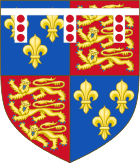 As descendants of the sovereign in the male line, the dukes of York bore the arms of the kingdom differenced by a label argent of three points, each bearing three torteaux gules | |
| Parent house | House of Plantagenet |
| Country | |
| Founded | 1385 |
| Founder | Edmund of Langley |
| Current head | Extinct |
| Final ruler | Richard III of England |
| Titles |
|
| Dissolution | 1499 |
| Deposition | 1485 |
Descent from Edward III
Edmund of Langley, 1st Duke of York, 1st Earl of Cambridge, KG (5 June 1341 – 1 August 1402) was a younger son of King Edward III of England and Philippa of Hainault, the fourth of their five sons who lived to adulthood. He was the founder of the House of York, but it was through the marriage of his younger son, Richard of Conisburgh to Anne Mortimer that the Yorkist faction in the Wars of the Roses made its claim on the throne. The other party in the Wars of the Roses, the Lancasters, were descendants of Edmund's elder brother, John of Gaunt whose son Henry usurped the throne of Richard II in 1399.
Edmund had two sons, Edward, and Richard. Edward succeeded to the dukedom in 1402, but was killed at the battle of Agincourt in 1415, with no issue. Richard married Anne Mortimer, a great-granddaughter of Lionel of Antwerp, the second surviving son (cadet line) of Edward III. Furthermore, Anne's son Richard also became heir general to the earldom of March, after her only brother, Edmund, 5th Earl, died without issue in 1425. Their father Roger Mortimer, 4th Earl of March had been named heir presumptive of Richard II before Henry IV's accession; although it had been passed over at the time, Anne's son Richard also inherited this claim to the throne.
Richard was executed following his involvement in the Southampton Plot to depose Henry V of England in favour of the Earl of March. The dukedom of York therefore passed to his son, Richard Plantagenet. Through his mother, Richard Plantagenet also inherited the lands of the earldom of March, as well as the Mortimer claim to the throne.
Wars of the Roses
Despite his elevated status, Richard Plantagenet was denied a position in government by the advisers of the weak Henry VI, particularly John Beaufort, 1st Duke of Somerset, and the queen consort, Margaret of Anjou. Although he served as Protector of the Realm during Henry VI's period of incapacity in 1453–54, his reforms were reversed by Somerset's party once the king had recovered.
The Wars of the Roses began the following year, with the First Battle of St Albans. Initially, Richard aimed only to purge his Lancastrian political opponents from positions of influence over the king. It was not until October 1460 that he claimed the throne for the House of York. In that year the Yorkists had captured the king at the battle of Northampton, but victory was short-lived. Richard and his second son Edmund were killed at the battle of Wakefield on 30 December.
Richard's claim to the throne was inherited by his son Edward. With the support of Richard Neville, 16th Earl of Warwick ("The Kingmaker"), Edward, already showing great promise as a leader of men, defeated the Lancastrians in a succession of battles. While Henry VI and Margaret of Anjou were campaigning in the north, Warwick gained control of the capital and had Edward declared king in London in 1461. Edward strengthened his claim with a decisive victory at the Battle of Towton in the same year, in the course of which the Lancastrian army was virtually wiped out.
Reigns of the Yorkist Kings
The early reign of Edward IV was marred by Lancastrian plotting and uprisings in favour of Henry VI. Warwick himself changed sides, and supported Margaret of Anjou and the king's jealous brother George, Duke of Clarence, in briefly restoring Henry in 1470–71. However, Edward regained his throne, and the House of Lancaster was wiped out with the death of Henry VI himself, in the Tower of London in 1471. In 1478, the continued trouble caused by Clarence led to his execution in the Tower of London; popularly he is thought to have been drowned in a butt of malmsey wine.
On Edward's death in 1483, the crown passed to his twelve-year-old son Edward. Edward IV's younger brother Richard, Duke of Gloucester, was appointed Protector, and escorted the young king, and his brother Richard, to the Tower of London. The famous Princes in the Tower were never seen again. However it is unknown whether they were killed or who might have killed them. Parliament declared, in the document Titulus Regius, that the two boys were illegitimate, on the grounds that Edward IV's marriage was invalid, and as such Richard was heir to the throne. He was crowned Richard III in July 1483.
Defeat of the House of York
Richard III had had many enemies. Though the House of Lancaster had been extinguished, the Lancastrian sympathisers survived, who now rallied behind Henry Tudor, a descendant of the Beauforts, a legitimized branch of the House of Lancaster. Furthermore, the family of Edward IV, and the Edwardian loyalists, were undeniably opposed to him, dividing his Yorkist power base. A coup attempt failed in late 1483, but in 1485 Richard met Henry Tudor at the battle of Bosworth Field. During the battle, some of Richard's important supporters switched sides or withheld their retainers from the field. Richard himself was killed. He was the last of the Plantagenet kings, as well as the last English king to die in battle.
Henry Tudor declared himself king, took Elizabeth of York, eldest child of Edward IV, as his wife, symbolically uniting the surviving houses of York and Lancaster, and acceded to the throne as Henry VII, founder of the Tudor dynasty which reigned until 1603.
Later claimants
The de la Pole family were sometimes suggested as heirs to the Yorkist cause, but Henry Tudor and his son Henry VIII of England efficiently suppressed all such opposition.
Another Yorkist branch descends from George Plantagenet, 1st Duke of Clarence, and younger brother of Edward IV. The heir to this branch is the Earl of Loudoun, currently Simon Abney-Hastings. There was in Edward IV's reign a suspicion that this king was illegitimate. In 2004, the British station Channel 4 revived the George branch's claim as "Britain's Real Monarch". The Earls of Loudoun would then, at least, be the heirs to the Yorkists.[3]
Legacy
Upon Henry Tudor's uniting the rival houses of Lancaster and York, the title Duke of York became a royal prerogative and is traditionally accorded to the second son of the reigning monarch. Beginning with Richard of Shrewsbury (son of Edward IV, one of the Princes in the Tower), none of its holders were able to transmit it; they either died without a male heir or succeeded to the throne. The title is held today by Prince Andrew, second son of Queen Elizabeth II and her consort Prince Philip, Duke of Edinburgh.
The symbol of the House of York was a white rose, still used as the badge of Yorkshire and Jacobitism. York, Pennsylvania, is known as the White Rose City after the symbol of the House of York. The rivalry between York and Lancaster, in the modern form of the counties of Yorkshire and Lancashire, has continued into the present day on a more friendly basis.
| House of York family tree | ||
|---|---|---|
|
Dukes of York
| Duke | Portrait | Birth | Marriages | Death |
|---|---|---|---|---|
| Edmund of Langley (House of York founder) 1385–1402 |  | 5 June 1341 Kings Langley son of Edward III of England and Philippa of Hainault | Isabella of Castile 1372 3 children Joan de Holland ca. 4 November 1393 no children | 1 August 1402 Kings Langley age 61 |
| Edward of Norwich 1402–1415 |  | 1373 Norwich son of Edmund of Langley and Isabella of Castile | Philippa de Mohun c. 1397 no children | 25 October 1415 Agincourt age 42 |
| Richard Plantagenet 1415–1460 | 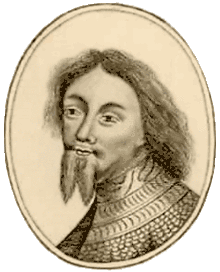 | 21 September 1411 son of Richard of Conisburgh, 3rd Earl of Cambridge and Anne de Mortimer | Cecily Neville 1437 12 children | 30 December 1460 Wakefield age 49 |
| Edward Plantagenet 1460–1461 | 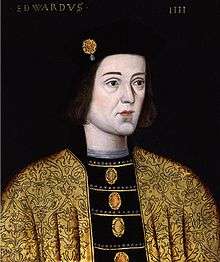 | 28 April 1442 Rouen son of Richard Plantagenet and Cecily Neville | Elizabeth Woodville 1 May 1464 10 children | 9 April 1483 Westminster age 40 |
Edward Plantagenet became Edward IV in 1461, thus merging the title of Duke of York with the crown.
Yorkist Kings of England
| Name | Portrait | Birth | Marriages | Death |
|---|---|---|---|---|
| Edward IV 4 March 1461 – 3 October 1470 11 April 1471–1483[4] |  | 28 April 1442 Rouen son of Richard Plantagenet, 3rd Duke of York and Cecily Neville[4] | Elizabeth Woodville Grafton Regis 1 May 1464 10 children[4] | 9 April 1483 Westminster Palace age 40[4] |
| Edward V 9 April–25 June 1483[5] |  | 2 November 1470 Westminster son of Edward IV and Elizabeth Woodville[5] | unmarried | c. 1483 London age about 12 (presumed murdered)[6] |
| Richard III 26 June 1483–1485[7] | 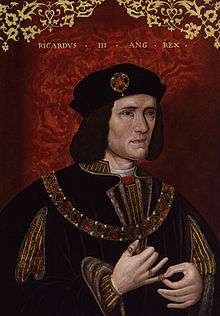 | 2 October 1452 Fotheringhay Castle son of Richard Plantagenet, 3rd Duke of York and Cecily Neville[8] | Anne Neville Westminster Abbey 12 July 1472 1 son[8] | 22 August 1485 Bosworth Field age 32 (killed in battle)[8] |
York badges
The most popular symbol of the house of York was the White Rose of York. The Yorkist rose is white in colour, because in Christian liturgical symbolism, white is the symbol of light, typifying innocence and purity, joy and glory.[9] During the civil wars of the fifteenth century, the White Rose was the symbol of Yorkist forces opposed to the rival House of Lancaster. The red rose of Lancaster would be a later invention used to represent the House of Lancaster, but was not in use during the actual conflict.[10] The opposition of the two roses gave the wars their name: the Wars of the Roses (coined in the 19th century).
 White Rose Badge of York.
White Rose Badge of York.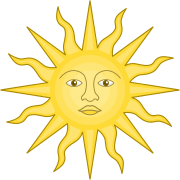 Sun of York.
Sun of York.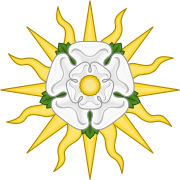 Rose en Soleil Badge of York.
Rose en Soleil Badge of York. White Lion of Mortimer Badge of Edward IV.
White Lion of Mortimer Badge of Edward IV. Falcon and Fetterlock Badge of Edward IV.
Falcon and Fetterlock Badge of Edward IV.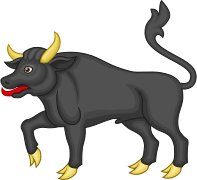 Black Bull of Clarence Badge of Edward IV.
Black Bull of Clarence Badge of Edward IV..svg.png) White Boar Badge of Richard III (Loyaulte Me Lie).
White Boar Badge of Richard III (Loyaulte Me Lie).
See also
Notes
- Morgan, Kenneth O. (2000). The Oxford Illustrated History of Britain. Oxford: Oxford University Press. p. 623. ISBN 978-0-19-822684-0.
- Chisholm, Hugh, ed. (1911). . Encyclopædia Britannica. 28 (11th ed.). Cambridge University Press. p. 924.
- "Channel 4 website devoted to "Britain's Real Monarch"". Channel 4. 3 January 2004.
- Edward was briefly deposed during his reign by Henry VI. Lundy, Darryl. "thePeerage.com – Person Page 10164". Retrieved 25 October 2007.
- Edward V was deposed by Richard III, who usurped the throne on the grounds that Edward was illegitimate. "EDWARD V - Archontology.org". Retrieved 25 October 2007.
- Lundy, Darryl. "thePeerage.com – Person Page 10165". Retrieved 25 October 2007.
- "RICHARD III - Archontology.org". Retrieved 25 October 2007.
- Lundy, Darryl. "thePeerage.com – Person Page 10163". Retrieved 25 October 2007.
- Herbermann, Charles, ed. (1913). . Catholic Encyclopedia. New York: Robert Appleton Company.
-
- The White Rose of Yorkshire, YorkshireHistory.com, retrieved 21 March 2008
References
- Neubecker, Ottfried; Harmingues, Roger (1982) [1976], Le Grand livre de l'héraldique, Paris: Bordas, p. 288, ISBN 978-2-04-012582-0
- Louda, Jiri; Maclagan, Michael (12 December 1988), "Netherlands and Luxembourg, Table 33", Heraldry of the Royal Families of Europe (1st (U.S.) ed.), Clarkson N. Potter, Inc.
- Pinches, John Harvey; Pinches, Rosemary (1974), The Royal Heraldry of England, Heraldry Today, Slough, Buckinghamshire: Hollen Street Press, ISBN 978-0-900455-25-4
External links
- The White Rose of York on the 'History of York' website.
- The Plantagenets on the official website of the British monarchy.
- The Yorkists on the official website of the British monarchy.
Royal house House of York Cadet branch of the House of Plantagenet | ||
| Preceded by House of Lancaster |
Ruling house of the Kingdom of England 1461–1470 |
Succeeded by House of Lancaster |
| Ruling house of the Kingdom of England 1471–1485 |
Succeeded by House of Tudor | |
.svg.png)
